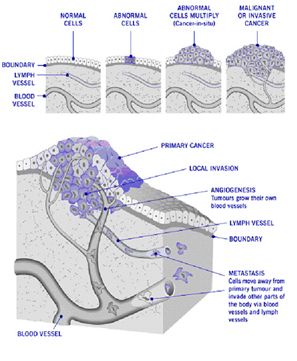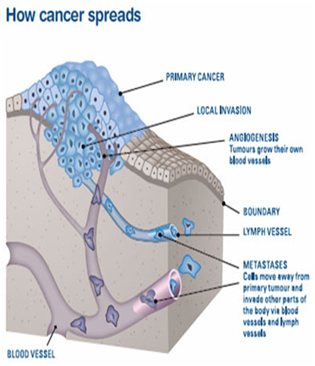| Cancer is a group of 100 different yet related diseases. Normal body cells divide and grow in an orderly fashion to maintain the growth of the body. However, cells affected by cancer start dividing and growing in an abnormal fashion and this abnormal growth damages normal body tissues and disrupt the ability of organs to function, as they should leading to Cancer. During the early years of a person's life, normal cells divide more rapidly until adult size is reached. After that, normal cells of most tissues divide only to replace worn-out tissue and to repair injuries.  Cancer cells, however, continue to grow. Often those cells form tumors (lumps) that compress, invade and destroy normal tissues. Unless the cancer is treated, the tumors can grow and spread. If cells break away from such a tumor, they can travel through the bloodstream or the lymph system to other areas of the body. There they may settle and form "colony" of tumors. In their new location, the cancerous cells begin to grow again. The spread of a tumor to a new site is called metastasis. Leukemia, a form of cancer, does not usually form a tumor instead, cancer cells invade the blood and blood-forming organs (spleen, lymphatic system, and bone marrow). It is important to realize that not all tumors are cancerous. Benign tumors, which stay in one place and have limited growth, are usually not life threatening. Cancer is classified by the part of the body in which it develops, by its appearance under the microscope, and by the results of laboratory tests. Since cancer is not a single disease, each type of cancer behaves differently. What's more, different cancers also respond in various ways to different types of treatment. That is why people with cancer need treatment, aimed at their specific form of the disease.  Cancer is not necessarily fatal. Today, millions of people are living with cancer. Risk of developing many forms of cancer could be reduced by positive changes in a person's lifestyle. The Patient's chances of surviving are high if the Cancer is identified and treated immediately at an early stage. Cancer is not necessarily fatal. Today, millions of people are living with cancer. Risk of developing many forms of cancer could be reduced by positive changes in a person's lifestyle. The Patient's chances of surviving are high if the Cancer is identified and treated immediately at an early stage. If cells keep dividing when new cells are not needed, a mass of tissue forms. This mass of extra tissue, called an abnormal growth or tumor, can be benign or malignant. Benign tumors are not cancer. They can usually be removed and in most cases, they do not grow again. Most important, cells from benign tumors do not spread to other parts of the body. Benign tumors are rarely a threat to life. Malignant tumors are real Cancer. Cancer cells can invade and damage nearby tissues and organs. Also cancer cells can break away from a malignant tumor and enter the bloodstream or the lymphatic system. This is how cancer spreads from the original (primary) tumor to form new tumors in other parts of the body. Most cancers are named for the type of cell or the organ in which they begin. When cancer spreads, the new tumor has the same kind of abnormal cells and the same name as the primary tumor. For example, if lung cancer spreads to the liver, the cancer cells in the liver are lung cancer cells. The disease is called meta static lung cancer (it is not liver cancer). |

